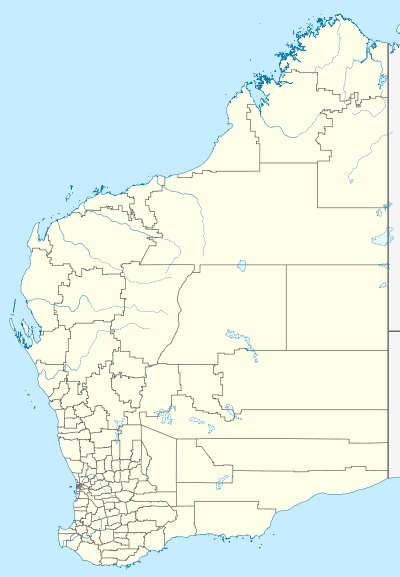Capel, Western Australia
| Capel Western Australia | |
|---|---|
 Capel | |
| Coordinates | 32°33′25″S 115°34′12″E / 32.557°S 115.57°ECoordinates: 32°33′25″S 115°34′12″E / 32.557°S 115.57°E |
| Population | 2,151 (2006 census)[1] |
| Established | 1897 |
| Postcode(s) | 6271 |
| Elevation | 19 m (62 ft) |
| Location | |
| LGA(s) | Shire of Capel |
| State electorate(s) | Collie-Preston |
| Federal Division(s) | Forrest |
Capel is a town in the South West region of Western Australia, located 212 kilometres (132 mi) south of Perth and midway between Bunbury and Busselton.
The town is located on the Capel River and is approximately 19 metres (62 ft) above sea level. Capel has a Mediterranean climate, with hot dry summers and cool wet winters. Daily temperatures range from 13 °C to 40 °C in summer, and from 5 °C to 27 °C in winter. Average annual rainfall is about 830 mm.
Historically, Capel is a farming area; traditional agricultural pursuits include dairy and beef. In recent times, Capel has become popular for hobby farms, and a number of innovative agricultural pursuits have been introduced, including alpacas, viticulture, aquaculture and growing of blue gums. There is also some mining of mineral sands in the Shire, and tourism is increasingly important to the Shire's economy.
The Capel area was settled very early in the history of colonial Western Australia. The Capel River was discovered by Frederick Ludlow in 1834, but it was not named until the Bussell family settled in the area. The name honours Capel Carter Brockman (1839–1924),[2] daughter of John Bussell (1803–1875),[3] who was named after a Miss Capel Carter, a cousin of the Bussells in England with whom Bussell family members corresponded. In the 1830s a number of settlers followed the Bussells into the area, and both James Stirling and John Hutt, (the first two Governors of Western Australia) took up land in the region. Plans to establish a townsite in the area were first mooted in 1844, but the site was not surveyed until the 1870s and lots were not sold until 1897. Initially the town was named Coolingnup, which is the Noongar Aboriginal name for the place; the name was changed to Capel in 1899.[4]
The population of the town was 91 (44 males and 47 females) in 1898.[5]
Westralian Sands was established in 1954 but commenced operations in 1959 when it started mining and processing the Yoganup deposit just north of the town. Another company, RGC, operated a mine to the south of the town. In 1998 both companies merged to form Iluka Resources which continues to operate ilmenite mines around the area and produce synthetic rutile at the processing facility to the north of the town along the Bussell Highway.
References
- ↑ Australian Bureau of Statistics (25 October 2007). "Capel (State Suburb)". 2006 Census QuickStats. Retrieved 29 August 2008.
- ↑ 'Brockman, Capel Carter (1839–1924)', Obituaries Australia, National Centre of Biography, Australian National University, accessed 7 April 2013.
- ↑ Freda Vines Carmody (1966) 'Bussell, John Garrett (1803–1875)', Australian Dictionary of Biography, Volume 1, (MUP)
- ↑ Western Australian Land Information Authority. "History of country town names – C". Retrieved 2007-06-08.
- ↑ "Population of Western Australia". Western Mail. Perth, Western Australia: National Library of Australia. 22 April 1898. p. 23. Retrieved 28 May 2012.